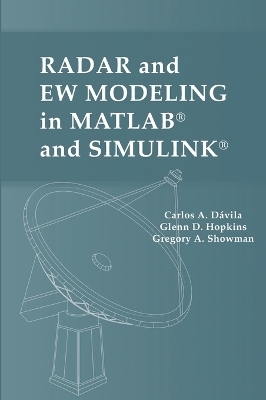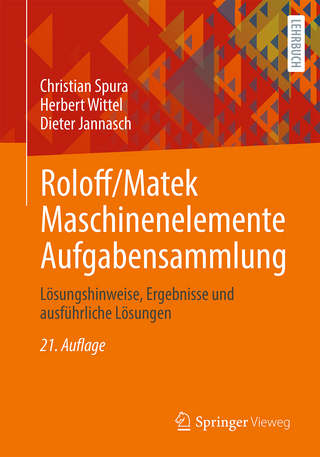
Radar and EW Modeling in MATLAB and Simulink
Artech House Publishers (Verlag)
978-1-63081-906-4 (ISBN)
Foreword
Preface
1.0 Introduction
1.1 Basic concepts and terminology
1.2 The M&S pyramid
1.3 Radar M&S
1.4 Concluding Remarks
1.5 References
2.0 The Radar Equation
2.1 Introduction
2.2 Derivation of the Radar Equation
2.3 MATLAB Model of the Radar Equation
2.4 Simulink Model of the Radar Equation
2.5 Concluding Remarks
2.6 References
3.0 Antennas
3.1 Introduction
3.2 Antenna Basics
3.3 Directivity Pattern Basics
3.4 Fields and Frequencies
3.5 Polarization
3.6 Isotropic Antenna Pattern
3.7 Directivity and Gain
3.8 Modeling Approaches
3.9 Fourier Transform Model Approaches
3.10 Fourier Transform Peak Directivity Normalization
3.11 Fourier Transform Model for Antennas That Are Not Arrays
4.0 Propagation
4.1 Introduction
4.2 Radar Horizon
4.3 Atmospheric Attenuation
4.4 Refraction
4.5 Multipath
4.6 Summary
4.7 References
5.0 Radar Cross Section
5.1 Introduction
5.2 The Concept of RCS
5.3 Scattering Surfaces
5.4 Scatterer Integration
5.5 Computational Electromagnetics
5.6 Swerling Models
5.7 RCS Table Look-Up
5.8 Concluding Remarks
5.9 References
6.0 Clutter
6.1 Introduction
6.2 From Target Models to Clutter Models
6.3 Principles of Area Clutter Modeling
6.4 Land Clutter Backscatter Coefficients
6.5 Land Clutter Backscatter Statistics
6.6 Land Clutter Discretes
6.7 Land Clutter Temporal Correlation
6.8 Site-Specific Clutter
6.9 Sea Clutter
6.10 Volume Clutter
6.11 Clutter Model Results
6.12 Summary
6.13 References
7.0 Radar Waveforms
7.1 Introduction
7.2 Taxonomy of Radar Waveforms
7.3 Continuous Wave (CW)
7.4 Pulse Waveforms
7.5 Waveform Generator Model
7.6 Concluding Remarks
7.7 References
8.0 Range and Doppler Processing
8.1 Introduction
8.2 Target Velocity and Doppler
8.3 The Fourier Transform
8.4 The Discrete Fourier Transform (DFT)
8.5 Pulse Compression Waveforms
8.6 Range Processing
8.7 Doppler Processing
8.8 Concluding Remarks
8.9 References
9.0 Monopulse Processing
9.1 Introduction
9.2 Monopulse Processing of a Two-Element Array
9.3 Extension to an N-Element Array
9.4 A Non-mathematical Description of Monopulse
9.5 Simulink Model of Monopulse Processor
9.6 Concluding Remarks
9.7 References
10.0 Transmitter and Receiver Components
10.1 Introduction
10.2 Single-Sideband (SSB) Upconverter
10.3 Amplifiers
10.4 Oscillator Phase Noise
10.5 I/Q Channel Mismatch
10.6 Filtering
10.7 Analog-to-digital Conversion
10.8 Concluding Remarks
10.9 References
11.0 Target Detection
11.1 Introduction
11.2 Data Processing and Detector Types
11.3 Noise and Target Statistics
11.4 Detection Figures of Merit (Pd and Pfa) and the Likelihood Ratio
11.5 ROC Curves
11.6 Noncoherent Integration
11.7 Detection Performance for Fluctuating Targets
11.8 CFAR Detectors
11.9 Binary (M-of- N) Detection
11.10 References
12.0 Pulse-Doppler & FMCW Signal Processors
12.1 Introduction
12.2 FMCW Processing
12.3 Pulse-Doppler Processing
12.4 Radar Processing Timeline and Swerling Fluctuation Models
12.5 Concluding Remarks
12.6 References
13.0 Target Tracking
13.1 Introduction and Basic Terminology
13.2 Radar Tracking Modes
13.3 Tracking Initiation and Management Process
13.4 Tracking M&S Considerations
13.5 Modeling Examples
13.6 Concluding Remarks
13.7 References
14.0 Engagement Geometry
14.1 Introduction
14.2 Coordinate Systems and their Transformations
14.3 Truth Calculation of Radar Observables
14.4 Simulink Model of Target Generator
14.5 Concluding Remarks
14.6 References
15.0 Engagement Simulation
15.1 Introduction
15.2 Extending the Radar Equation Model
15.3 Initial Engagement Model
15.4 Full Engagement Model
15.5 Example Single Radar vs. Single Target Engagement
15.6 Concluding Remarks
15.7 References
16.0 M&S of EA
16.1 Introduction
16.2 EA Concepts
16.3 Coherent Repeater EA
16.4 Engagement Simulation with Coherent Repeater EA
16.5 Noise EA
16.6 Engagement Simulation with Noise EA
16.7 Concluding Remarks
16.8 References
17.0 M&S of EP
17.1 Introduction
17.2 Antenna EP Concepts
17.3 Modeling of Antenna EP
17.4 Adaptive Beamforming
17.5 Concluding Remarks
17.6 References
18.0 M&S of ES
18.1 Introduction
18.2 Instantaneous Frequency Measurement (IFM) Modeling
18.3 Generic ES Processor Modeling
18.4 Time Difference of Arrival (TDOA) Modeling
18.5 Concluding Remarks
18.6 References
Appendix A - Common Sources of Discrepancy and Confusion in Radar M&S
Appendix B - MATLAB Refresher (Online)
Appendix C - Simulink Refresher (Online)
List of Acronyms and Abbreviations
Author biographies
Index
| Erscheinungsdatum | 07.11.2023 |
|---|---|
| Verlagsort | Norwood |
| Sprache | englisch |
| Themenwelt | Technik ► Maschinenbau |
| Technik ► Nachrichtentechnik | |
| ISBN-10 | 1-63081-906-9 / 1630819069 |
| ISBN-13 | 978-1-63081-906-4 / 9781630819064 |
| Zustand | Neuware |
| Haben Sie eine Frage zum Produkt? |
aus dem Bereich


